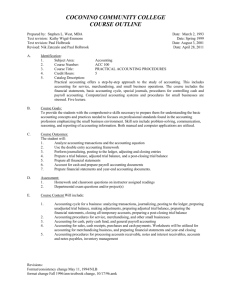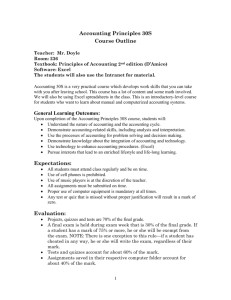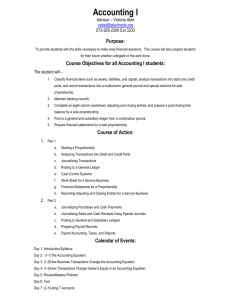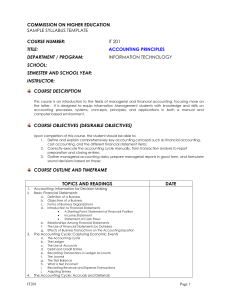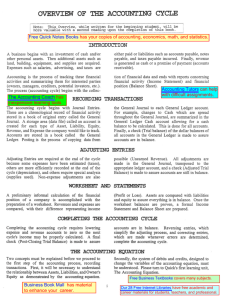Accounting I - Gayville-Volin School Board Information Portal
advertisement
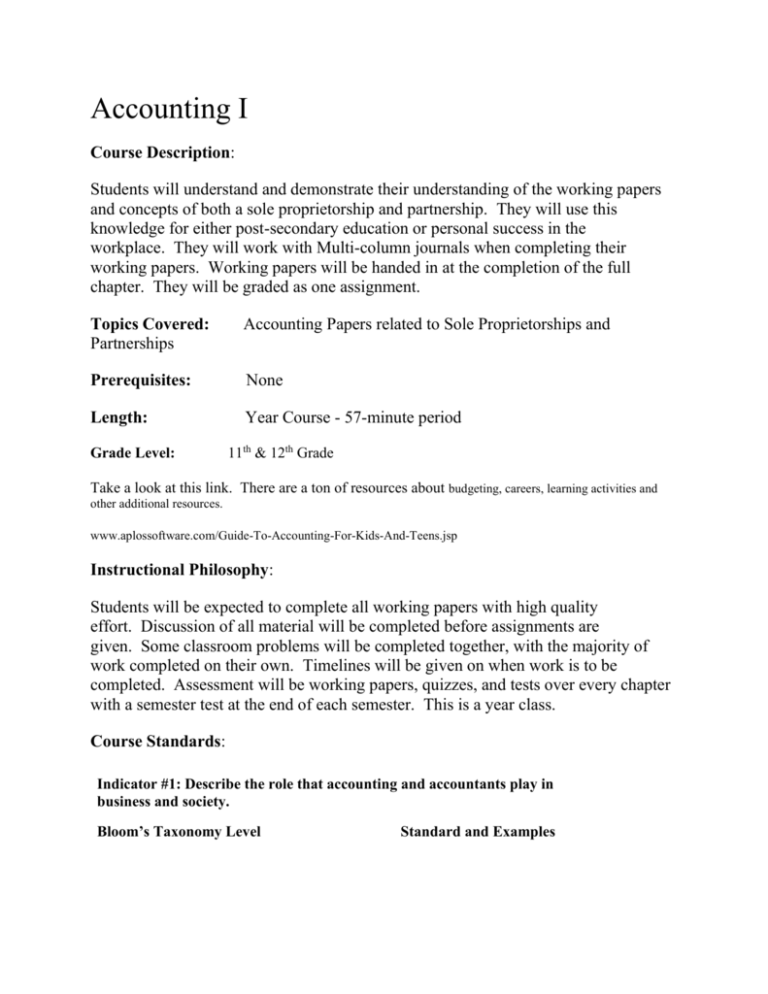
Accounting I Course Description: Students will understand and demonstrate their understanding of the working papers and concepts of both a sole proprietorship and partnership. They will use this knowledge for either post-secondary education or personal success in the workplace. They will work with Multi-column journals when completing their working papers. Working papers will be handed in at the completion of the full chapter. They will be graded as one assignment. Topics Covered: Partnerships Accounting Papers related to Sole Proprietorships and Prerequisites: None Length: Year Course - 57-minute period Grade Level: 11th & 12th Grade Take a look at this link. There are a ton of resources about budgeting, careers, learning activities and other additional resources. www.aplossoftware.com/Guide-To-Accounting-For-Kids-And-Teens.jsp Instructional Philosophy: Students will be expected to complete all working papers with high quality effort. Discussion of all material will be completed before assignments are given. Some classroom problems will be completed together, with the majority of work completed on their own. Timelines will be given on when work is to be completed. Assessment will be working papers, quizzes, and tests over every chapter with a semester test at the end of each semester. This is a year class. Course Standards: Indicator #1: Describe the role that accounting and accountants play in business and society. Bloom’s Taxonomy Level Standard and Examples Understanding A1.1.1 Describe career opportunities in the accounting profession. Examples: • Identify career opportunities in the accounting profession • Identify skills and competencies necessary to accomplish educational requirements • Identify job opportunities within the accounting profession Indicator #2: Examine the role of accounting in business. Bloom’s Taxonomy Level Standard and Examples Analyzing A1.2.1 Compare and contrast various types of business ownership and accounting principles that apply. Examples: • Explain how the different forms of business ownership are reported in the financial statements • Classify business ownership as sole proprietorship, partnership or corporation • Explain how and why the concepts and the generally accepted accounting principles provide guidance and structure for preparing financial statements Applying A1.2.2 Prepare and comprehend proper cash management techniques. Examples: • Identify cash control techniques • Prepare banking documents and / or forms such as deposit slips, checks, etc. • Prepare a bank statement reconciliation form • Prepare a petty cash form Indicator #3: Demonstrate the basic principles and procedures of the accounting cycle. Bloom’s Taxonomy Level Standard and Examples Analyzing A1.3.1 Examine, analyze and categorize financial transactions. Examples: • Classify assets, liabilities and owners’ equity • Demonstrate usage of T accounts • Analyze transactions into debit and credit parts • Prepare a chart of accounts Applying A1.3.2 Apply the accounting equation as a guide to journalize basic transactions into a journal. Examples: • Specify various journals such as general journal, multi-column journal and / or special journal • Computer software may be utilized to perform journalizing to demonstrate journal usage • Apply the double-entry system of accounting to record business transactions • Total, prove and rule journals Applying A1.3.3 Post information from journals of all types into general and subsidiary ledger accounts. Examples: • Demonstrate use of posting separate amounts from a journal to a the general ledger and / or subsidiary ledger • Post column totals from a journal to the general ledger Evaluating A1.3.4 Complete payroll using appropriate accounting practices. Examples: • Complete payroll time cards and payroll register • Calculate gross earnings including benefit packages • Determine net pay and prepare payroll checks for employees • Compute payroll deductions to be able to prepare tax forms • Determine net pay, with previously calculated payroll deductions Indicator #4: Create and interpret financial statements. Bloom’s Taxonomy Level Standard and Examples Applying A1.4.1 Complete and examine an accounting worksheet. Examples: • Prepare a trial balance from the general ledger accounts • Calculate, journalize and post adjusting and closing journal entries • Extend and complete worksheet to determine net gain or net loss Applying A1.4.2 Prepare and interpret formal end of fiscal year financial statements. Examples: • Prepare balance sheet • Prepare income statement • Prepare owners’ equity statement • Prepare post-closing trial balance Major Assignments 1. Chapters 1-17 Working Papers (8-12 assignments in each group of working papers) 2. 2 Reinforcement Activities (After chapters 6 and 9, and after chapters 14 & 17) 3. Business Simulations - Foreign Exchange (Sole Proprietorship) & Fitness Junction (Partnership) 4. Chapter Tests after each chapter Instructional Delivery Plan: Delivery Method: Instruction will consist of lecture, discussion, reading, problem solving, and writing, Examples done together in class. Student Work: Students will work independently on tests, quizzes, and performance task. Student can work independently or in teams on working papers and business simulations. Community Involvement: Guest speakers from accounting firms and the community, if available, will be brought in throughout the course. Trips to career fairs may be done during the year with me and/or the counselor. Grading Scale: A 100-94 Excellent Work, all assignments completed and shows understanding of work B 93-86 Good Work, all assignments completed and shows understanding of work C 85-78 Decent work, missing a few assignments and shows understanding of most work, missing effort D 77-70 Borderline Work, missing assignments and late assignments, basic understanding of most work, lack of effort F 69 and below Minimal Effort, many missing assignments, understanding is below basic, does not meet expectations. Grading Distribution: Students will be graded based on total points. Distribution will be as followed (approximate): Tests & Quizzes 10% Working Papers 60% Reinforcement 10% Problems Business Simulations 20% Chapter Descriptions: Book-Century 21 Accounting Chapters 1-17 Chapter 1-Starting a proprietorship- assets, equities, liabilities, owners equity, accounting equation, transaction, account balance, capital, account, account title, balance sheet Chapter 2- Changes that affect owner's equity- revenue, expenses, withdrawals Chapter 3- Analyzing transactions into debit and credit parts-T accounts, normal balance, debit, credit, chart of accounts Chapter 4-Journalizing transactions-journal, journalizing, entry, double-entry accounting, general amount column, source document, check, invoice, sales invoice, receipt, memo, tapes, proving and ruling a journal, proving cash Chapter 5-Posting to a general ledger- ledger, general ledger, account number, file maintenance, opening an account, posting, column totals, correcting entries Chapter 6-Cash control systems- checking accounts, endorsements, blank, special, restrictive, postdated check, bank statement, reconciliation, dishonored checks, EFT, debit cards, Petty cash Chapter 7-Worksheet- Fiscal period, trial balance, adjustments, income statement, balance sheet, net income, net loss Chapter 8-Financial statements for a proprietorship- Component percentage, asset, liability, owners equity portions of balance sheet Chapter 9-Record adjusting and closing entries- adjusting entries, closing entries, permanent accounts, temporary accounts, post-closing trial balance Chapter 10-Journalizing purchase and cash payments - partnerships, types of businesses, markup, vendor, cost of merchandise, purchase invoice, terms of sale Chapter 11-Journalize sales and cash receipts- customers, sales tax, cash sale, credit card sales Chapter 12-Posting to ledgers- subsidiary ledgers, AP ledger, AR ledger, controlling account Chapter 13-Preparing payroll records- Salary, pay period, payroll, total earnings, payroll taxes, withholding allowances, S.S. tax, Medicare tax, payroll register, net pay, employee earnings record Chapter 14-Payroll accounting, Taxes- Journalizing payment of a payroll, employer payroll taxes, unemployment taxes (state and federal), W-2's, 1040ez, employer's quarterly federal tax return form, w-3, Paying withholding and payroll taxes Chapter 15-Worksheet for a merchandise business- 8 column worksheet for a merchandising business, inventory, merchandise inventory, adjustments Chapter 16-Financial statements for a partnership-cost of merchandise sold, gross profit on sales, acceptable and unacceptable percentages of net income, expenses, and sales, distribution of net income, owners equity statement, supporting schedule Chapter 17-Recording adjusting and closing entries for a partnership- adjusting entries, closing entries, income summary, recording adjusting and closing entries, post-closing trial balance Extra Help: Students are required by policy to come in at 7:45 for extra help in a subject. There are also days available after school for a student to come in for extra help. Contact me and I'll work something out to find a time that works to help the student.
